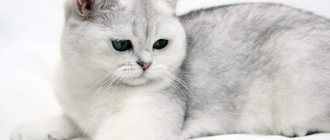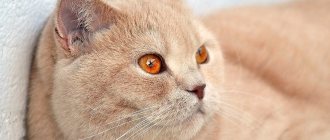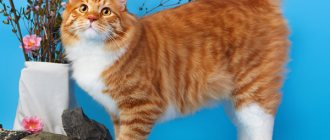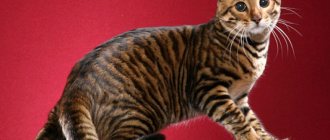History of the Japanese Bobtail breed
Japanese bobtails are over a thousand years old.
It is assumed that the first mustachioed mousecatchers arrived on the islands from China, but they looked different then, and their tails were initially of normal length. Subsequently, as a result of a gene mutation, this part of the body lost the appearance to which we are accustomed. Thus, the classic tail was replaced by a short “squiggle”, disguised with airy fur as a “pompom”. The Japanese, steeped in folk signs and superstitions, considered this change a good sign: long tails in this part of Asia were never welcomed and were identified with a dark, evil entity. Well, since this part of the spine of the bobtail ancestors had insignificant dimensions, the bobtail cats were given the “green light” to reproduce. In national culture, traces of Japanese bobtails can be traced back to the 16th century, when Asian artists discovered ideal sitters in cats and began to depict them on their canvases. By this time, bobtails managed not only to gain the trust of the Japanese rulers, but also to completely occupy the palace chambers and country residences of the emperor, as well as his entourage.
It is unknown how long the breed would have managed to maintain its privileged status if not for the large-scale invasion of rodents that invaded the Land of the Rising Sun in 1602. Driven by hunger, the rats mercilessly dealt with the food supplies of the townspeople, mulberry trees and even silkworm larvae. To stop the mouse chaos, the emperor made an extraordinary decision: the ruler issued an urgent decree ordering cat owners to release their furry charges onto the city streets. Thanks to this, Japanese bobtails received complete freedom of action in terms of reproduction and “pumping” of the genotype.
The breed owes its move to the USA and European countries to the American breeder of Abyssinian cats and part-time leading CFA specialist Elizabeth Freret. Despite the fact that Japan’s self-isolation had sunk into oblivion by that time, Asians were clearly in no hurry to share their bob-tailed mousetraps with the rest of the world. However, in 1967, the woman managed to buy three Japanese bobtails and deliver them to America. Subsequently, Mrs. Freret’s mustachioed “troika” was joined by several more short-tailed purrs, almost smuggled out of Japan. They later became the main producers of the American line of the breed.
In 1968, the Japanese Shorthair Bobtail was standardized with CFA registration. This was serious progress, since in the homeland of cats they were not keen on maintaining documentation, preferring to breed animals without any paper formalities. As for long-haired individuals, their path to recognition by felinological associations turned out to be several decades longer. At first, overly fluffy kittens that slipped through litters of bobtails with short fur coats were mercilessly culled. However, after turning to historical sources, it turned out that at the court of the Japanese emperor, long-haired bobtails were bred on a par with their short-haired counterparts. As a result, the variety received the right to exist only in 1991, and then after persistent requests from breeders.
Japanese Bobtail breed standard
The Japanese Bobtail is a long-legged, muscular handsome guy with an oriental face and a funny pom-pom instead of the usual tail. From an aesthetic point of view, males look the most advantageous: they are usually larger and heavier than cats. However, at exhibitions, the “girls” of the Japanese bobtail are also not deprived of attention, which allows them to periodically acquire champion diplomas. The weight of Japanese Bobtails should be 5-7 kg for males and 4-5 kg for females.
Head
The Japanese Bobtail's skull resembles an equilateral triangle. In general, the animal’s head is characterized by high cheekbones and sculptural contours. The whisker pads are clearly visible.
Nose
Wide, fairly long, with a shallow transition to the forehead.
Eyes
The wide-open, but not bulging eyes of the Japanese Bobtail are set slightly obliquely and have the shape of a regular oval.
Ears
Large, erect, widely spaced. It is desirable that the inner surface of the ear linen be well-furred, and that there are tassels on the ear itself.
Frame
Japanese bobtails are built quite harmoniously. The cat's body is long, but not massive and not overly fragile. In general, the animal looks slightly lean, but not emaciated.
Limbs
The high legs of Japanese bobtails have different lengths (the back ones are longer than the front ones), but this does not “break” the top line, that is, the back of a standing cat remains in an emphatically horizontal position, without a pronounced slope. The animal's paws are oval, well assembled.
Tail
Japanese Bobtails have a curled tail that resembles a ball of fur, the length of which should not exceed 7.6 cm when extended. Typically, the “configuration” of this part of the body is unique to each individual cat. However, there are several common breed types of tails, including curled, knotted, corkscrew and curled variants. Depending on the direction of the curl, the tails of Japanese bobtails are divided into chrysanthemums and spirals. In the first case, the tail vertebrae are arranged in a circle, forming a regular ring, and in the second case, the bend has an open shape.
Wool
The coats of short-haired Japanese bobtails look very neat due to the soft semi-long hair and the almost complete absence of undercoat. Long-haired cats have hair that is just as silky, but longer. In addition, the “clothing” of representatives of the second variety is often heterogeneous. For example, relatively short fur in the shoulder area can gradually lengthen towards the tail and paws, forming light “knickers” on the hips.
Color
The Japanese Bobtail can have any coat color, except for obvious hybrid variations such as color point, chocolate, lilac and ticked tabby.
Disqualifying faults
The vast majority of Japanese Bobtails are disqualified from exhibiting due to tail defects. In particular, if the tail is absent as such, slightly pubescent and does not look like a pompom, there is no point in showing the animal to the breeding commission. Cats with the so-called “retracted bobtail” effect, when the pom-pom is removed from the back at a distance of 2.5 cm, will also not have an exhibition career.
Interesting Facts
Close relatives of Japanese bobtails live in the Kuril Islands, in the area of Iturup and Sakhalin. Only their popularity increased in the 90s. last century. Cats from this area belong to the Kurilian Bobtail breed.
They have long hair and also a strange tail shape. A fur coat of wool reliably protects from the cold, and on the front paws there are even downy “pants” that cats inherited from their Siberian ancestors.
Personality of the Japanese Bobtail
If you are hoping to find a sedate Oriental in the Japanese Bobtail, condescendingly allowing himself to be loved in exchange for treats and respectful treatment, then you are in the wrong place. The Asian mentality is, of course, present in the breed, but in such a muted form that it often begins to seem as if it never existed at all. Hot temperament, irrepressible curiosity and a passion for adventure are the main qualities that have given the Japanese Bobtail a reputation as the most unpredictable pets. Moreover, kittens are especially uncontrollable in childhood: overwhelmed by a thirst for new knowledge and impressions, kittens sometimes do tricks that you wouldn’t expect from them.
A Japanese Bobtail can absolutely sincerely love its owner, but this does not oblige him to watch TV series with him and work as a watchman for his master’s lap. And all because the furry “samurai” always have a couple of interesting activities in stock that require immediate intervention. What kind of TV is there when such prospects loom on the horizon! Of course, from time to time the cat is not averse to clinging to his owner’s side and having a heart-to-heart talk, but keeping him close to you against his will is unlikely to be possible.
In an informal setting, Japanese bobtails love to try on the role of fluffy whistleblowers, so don’t even try to tightly close interior doors and slam cabinets tightly: they will open it anyway, they will carry out an audit, and they will also be dissatisfied. Get used to the fact that purrs won’t ask permission for their next prank either. If the Japanese Bobtail liked a butterfly that fluttered onto the chest of drawers, he will get it, and he doesn’t care that somewhere in the background you are making scary eyes and waving something there.
In general, the Japanese Bobtail is an incredibly talkative breed, and cats prefer to share their impressions not with their fellow tribesmen, but with humans. Are you ready to listen to oriental legends told in a low, hoarse voice in the evenings? However, even if you are not ready, it doesn’t matter to the Japanese Bobtail: he has decided - he will tell you, and you decide for yourself what to do with the information received. Representatives of this breed do not suffer from loneliness at all, so feel free to go to the office or visit - the pet will have a great time, and most importantly, will spend time usefully without you. True, it is possible that later you will have to eliminate the consequences of cat entertainment, although it is difficult to expect outright crime from Japanese bobtails - unless the kitten is very small and desperately misses you.
Japanese Bobtails are friendly cats that willingly accept other purrs into their circle. Preference is always given to natives of the Land of the Rising Sun. By the way, if two “Asians” move into the house at once, get ready for a conspiracy, because group crimes for these furry “Yakuza” are an incomparable thrill. Cats usually do not conflict with dogs, so you can take a Japanese bobtail into the company of a dog you already have at home without unnecessary fears, of course, provided that your second pet is not a desperate cat hater.
Coloring Features
The Japanese Bobtail is distinguished by a faded color compared to the same Thai Bobtail, which has a contrasting coat. But cats of bright colors are also found in this breed, although less often. They are considered the most valuable. There are several color options:
- tricolor or mi-kay;
- fiery red;
- snow-white;
- black.
The eyes of a cat most often have a slight yellow tint, while in an animal with a white color they are blue. But sometimes animals are born with different colored eyes. This is especially true for snow-white kittens.
This variety is always worth higher than the standard options, because such an individual will always produce kittens with different eyes.
Education and training
On the one hand, Japanese bobtails are stubborn, no matter what. On the other hand, they are terribly smart and reach unprecedented heights in training. So, if you want to teach your cat a few tricks, seize the right moment when the pet is in a good mood. If you manage to arouse the purr’s interest and intrigue him with his activities, consider the most difficult part of the work done.
As for the selection of exercises, most of all Japanese Bobtails like to fetch rubber toys, catch an imaginary fly on command and do a stand on their hind legs. Jumping through a gymnastic hoop or barrier is easy for the breed. Since in their free time cats often “fly” from the closet to the sofa and back, practicing this skill on any sports equipment, including the same hula hoop, will not be difficult.
On the street, Japanese bobtails are walked almost like dogs, that is, on a harness. True, provided that you introduced the cat to this item in advance. Usually, in order to accustom a “Japanese” to walking on a leash, a traditional technique common to all cat breeds is sufficient. First, show your pet the harness and let him smell it. Then leave the strap near the cat's bed so that the animal gets used to it. At first, wear the harness at home and only for a few minutes. If the Japanese Bobtail shows suspicion and does not want to get into the collar, you can appease it with a piece of some yummy food.
Owner reviews
The few happy owners of the Japanese Bobtail speak of their animals as smart, energetic and loyal cats that are not characterized by aggression. Representatives of this breed choose one family member as an object of adoration. They are also friendly towards others, but pay less attention to them. Cats are patient with children and do not let out their claws, but they can ignore and avoid babies if they are too persistent in showing love.
Undoubtedly, this breed is worthy of attention, because it was bred naturally, and its representatives have gone through a long and difficult path of development. They had to endure hunger, survive on the streets, and face rejection from superstitious people. All this hardened the animals, made them strong, strong, fast and dexterous.
Maintenance and care
Japanese Bobtails have virtually no undercoat. For the breeder, this feature is one big plus: there is a minimum of hair on the carpets during the molting period, which cannot be said about the cats themselves. Deprived of a protective downy layer that insulates the body from environmental influences, the “Japanese” are very sensitive to any drop in temperature and drafts. For this reason, find a truly warm and protected place for the cat basket. But without fanaticism: a bed next to a heating radiator is a serious overkill.
Hygiene
As for caring for Japanese bobtails, it all depends on which type of breed you own. If you have a short-haired bobtail in your home, you can relax, because a representative of this family will need to comb its “coat” no more than once a week. Long-haired “Japanese” dogs will have to pay more attention, because they need to be combed over their muscular bodies every day. In addition, shedding in long-haired cats is always more pronounced and mainly in the spring.
Japanese bobtails are bathed only in situations where they really cannot do without washing. These “Asians” are not afraid of water, but they will have to tinker with the process, if only because the breed’s wool has a strong water-repellent effect. Accordingly, trying to wet a cat’s “fur coat” will take much more time than the actual washing process. Cleaning the ears of a Japanese Bobtail follows the classic scenario: once a week, look into the cat’s ear canal. If it is dirty and smelly, go over the inside of the ear with a cloth soaked in alcohol-free veterinary lotion.
In especially severe cases, ear drops for cats will help, softening dried wax and dirt. Just don’t go to extremes by trying to penetrate into the very depths of the passage - you risk damaging your hearing. Trimming the Japanese Bobtail's nails is an optional event. If the pet is accustomed to the scratching post and uses it regularly, this is enough. But rubbing your cat’s eyes in the morning with herbal lotions or herbal infusions should become a tradition.
Feeding
Japanese bobtails are not entitled to any special “Asian” menu. Short-tailed purrs eat everything that other breeds do, that is, lean meat, boiled sea fish fillets and liver, which are recommended to be “enhanced” with viscous porridge based on rolled oats and buckwheat. However, like true Japanese, bobtails often prefer seafood over cold cuts. Once a week, the cat’s diet must be additionally “vitaminized” with chicken yolk, quail egg, fresh herbs or wheat sprouts. Low-fat fermented milk products are also beneficial for the breed, as are fruit and vegetable shavings.
The simplest and easiest way to feed a Japanese Bobtail is to switch it to industrial drying. However, most kittens from nurseries are already “sitting” tightly on it by the time they move to a new home. Therefore, the only thing that is required from the new owner in such a situation is to promptly fill the plate with dry croquettes and add fresh water to the bowl.
Feeding the cat
Energetic and active Japanese people need a balanced diet that contains all the necessary vitamins and minerals.
Complete diet
Many breeders prefer to feed Japanese bobtails with premium or super premium dry food. It is good because it already contains all the necessary vitamins and microelements. The main thing is that it does not contain wheat, soy, dyes or other dubious additives. The following brands of food are optimally suited to these requirements:
- Hills;
- Arden Grange;
- Brit Care;
- Bosch.
With a natural type of nutrition, the diet of the Japanese Bobtail is designed so that meat predominates in it. The cat should also receive:
- porridge;
- offal;
- vegetables;
- eggs;
- sour milk;
- ocean fish.
To avoid problems with the digestive system and health in general, the Japanese Bobtail should not be given sweets, pickles, smoked foods, sausages, pork and starchy vegetables. It is also forbidden to feed the cat river fish, fresh milk, exotic fruits and any leftovers from the owner’s table.
Feeding frequency
Little Japanese eat less, but more often than adult representatives of the breed. Therefore, when drawing up a feeding schedule, you need to focus on the age of the cat:
- up to 16 weeks – 6 times a day;
- 4-5 months – 5 times a day;
- 5-9 months – 4 times a day;
- 9-12 months – 3 times a day.
A one-year-old Japanese bobtail is fed twice a day.
Vitamins and minerals
When feeding natural products, a cat’s body may lack certain microelements. To compensate for this deficiency, the Japanese Bobtail is given vitamin complexes twice a year in courses.
Important! Before introducing mineral supplements into the Japanese diet, you should consult a veterinarian.
How to choose a kitten
Unlike their Kuril relatives, Japanese bobtails still remain exotic in Russia, and the nurseries that breed them can be counted on the fingers of one hand. For example, for this period of time, only one organization with WCF and CFA registration, as well as an official website on the Internet, is a confident leader - this is the Innosima nursery.
By the way, don’t expect that a Japanese Bobtail will be sold to you right away. Firstly, due to the relative rarity of the breed, kittens have to be reserved long before birth. Secondly, most nurseries prefer to give promising babies to professional breeders and felinologists, leaving individuals with defects in appearance to ordinary buyers.
General rules for choosing a Japanese Bobtail:
- Don’t be surprised by the unusually large dimensions of the kittens. Japanese Bobtails grow and gain weight faster than most of their relatives;
- evaluate the appearance of a potential pet by checking the breed standard. Pay special attention to the tail configuration, which is a defining breed characteristic of Japanese Bobtails;
- do not neglect the opportunity to meet litter producers. This will make it easier to understand what exactly awaits you when your pet reaches full physical maturity;
- veterinary passport, birth certificate of the Japanese Bobtail kitten, pedigrees of its parents - all these documents must be carefully studied during their stay in the nursery.
Diseases
Since this is a native breed, no genetic pathologies have been identified in them. There are no claims to immunity either.
The only caveat: due to the lack of undercoat, bobtails easily catch colds. Therefore, make sure that there are no drafts in the apartment, let the cat dry thoroughly after water treatments, and also, do not allow the animal, hot after playing, to sit under the open window.
Everything else is standard. Helminths need to be driven out even if your cat does not go outside. These parasitic worms can live not only in the soil or other people's excrement, but also remain on raw meat, fish, and you can bring them into the house on your own hands or shoes. They are easy for humans to become infected with, so remember: Pirantel, Kanikvantel, Troncil K, Prazitel have proven themselves well in the pharmaceutical market. They can be given to a kitten from 3 months. A year - 4 times, if the cat stays at home, more often for street cats. After 2 weeks, cats can be vaccinated.
Expert opinion
Dusheba Vera Ivanovna
In 2010, she graduated from the Moscow State Academy of Veterinary Medicine named after K.I. Scriabin with honors, specializing in veterinary medicine. I regularly attend veterinary conferences, congresses, and webinars.
Cats nursing babies, as well as pregnant cats, should not be given medications! You should be more careful with cats that are elderly, weakened after illness, or exhausted. To be sure that you do not harm your pet, consult your doctor first. The veterinarian will examine the animal, take the necessary tests, and possibly prescribe additional tests.











